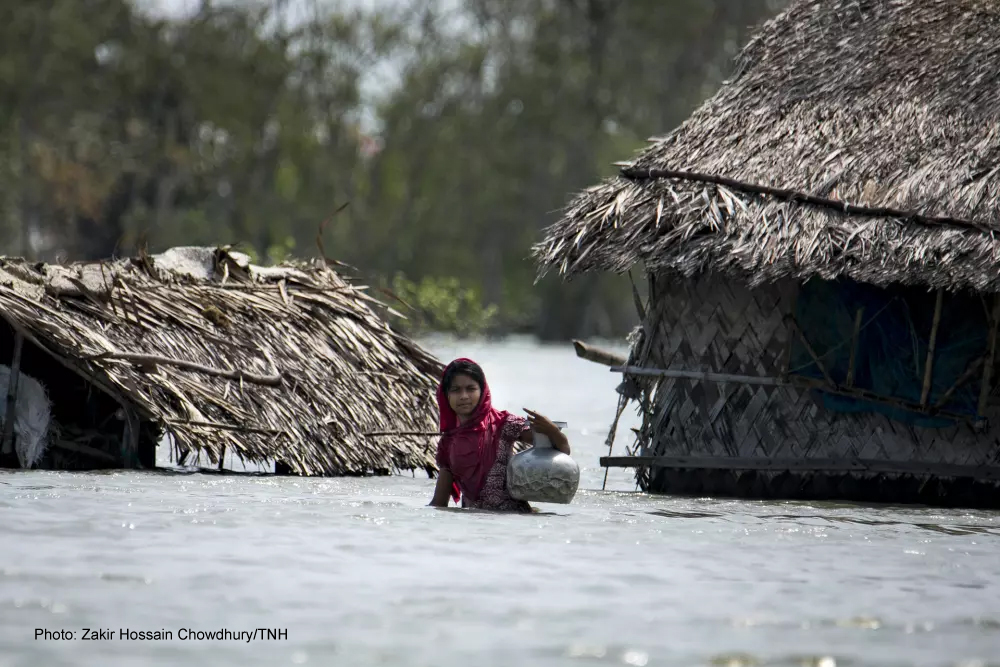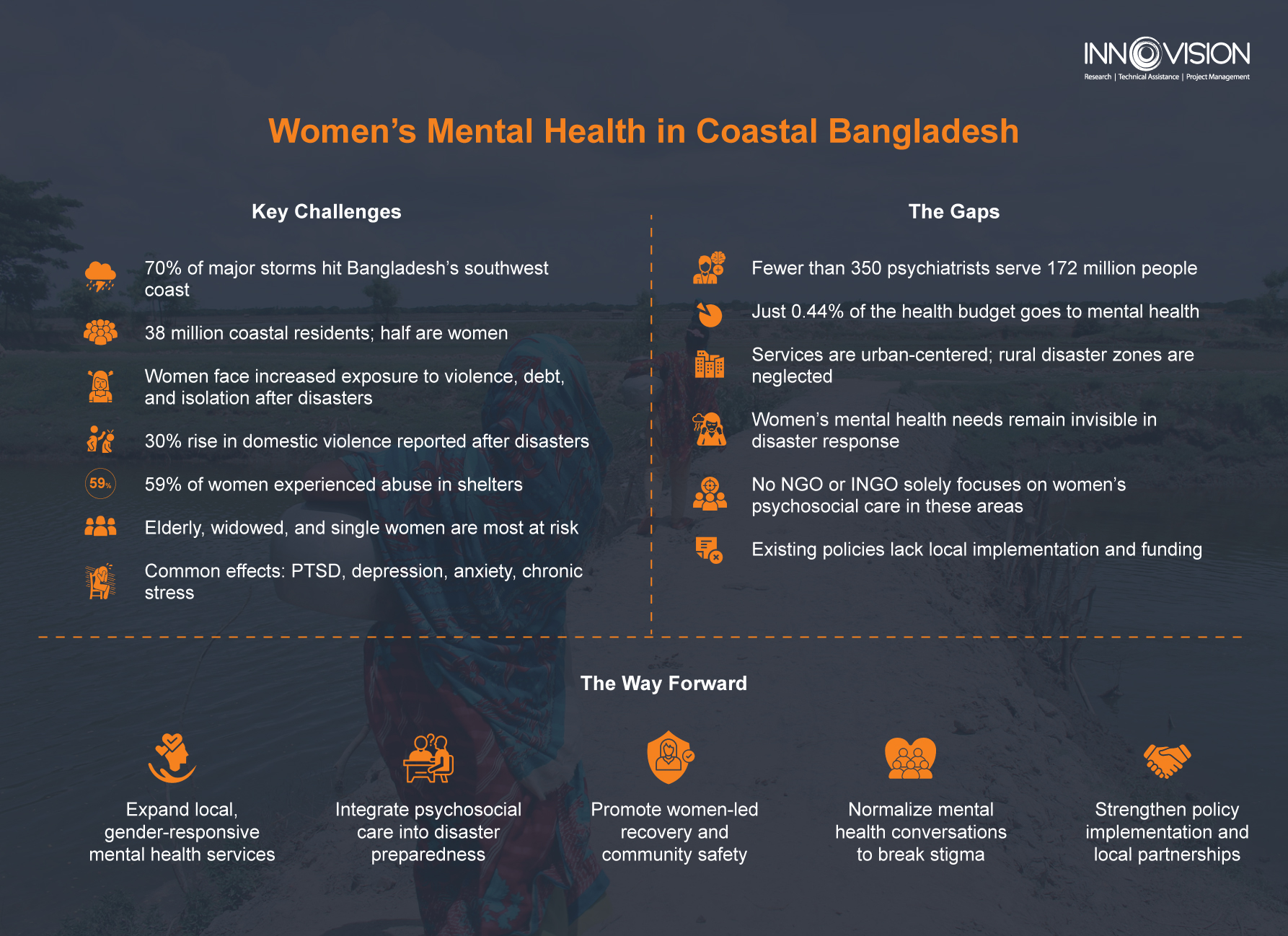
Approximately 70% of major storms and cyclones in the Bay of Bengal impact the Southwest coastal region of Bangladesh, where around 38 million people reside along the country’s coastal belt, half of whom are women (BBS, 2022). Climate-induced challenges further intensify the existing gender inequities faced by women in coastal areas such as Satkhira, Bagerhat, and Khulna, making these the most vulnerable regions of Bangladesh both during and after natural disasters.
Reflecting the broader national context, Bangladesh ranked as the 7th most affected country globally by extreme weather events between 2000 and 2019, according to the Global Climate Risk Index 2021 published by Germanwatch. With a Climate Risk Index (CRI) score of 28.33, the country experienced 185 climate-related events, averaging 572.50 fatalities annually, equivalent to 0.38 deaths per 100,000 inhabitants. The economic toll was also substantial, with losses amounting to approximately USD 1,860.4 million (in Purchasing Power Parity) about 0.41% of national GDP. These statistics underscore Bangladesh’s acute exposure to climate risks and reinforce the urgency of addressing gendered vulnerabilities in the Southwest coastal region (Eckstein et al., 2021).
Innovision Consulting recently conducted a study in the coastal regions of Bangladesh to identify Gender Gaps in Climate Change Adaptation Initiatives. One of the specific objectives of this study was to identify existing gender-specific vulnerabilities during and after natural disasters. A major concern identified in the study is the psychological and mental health toll on women during and after disasters. The triggering factors are multifaceted, including experiences of sexual harassment and gender-based violence (GBV), disruption of social support systems, economic displacement, high-interest debt, and the mental burden of managing families in resource-scarce post-disaster environments.
The destruction of essential household resources, scarcity of basic necessities, and the burden of managing the household after a disaster place immense pressure on women. Additionally, GBV significantly increases in post-disaster contexts, disproportionately affecting women’s and girls’ mental health. Innovision’s field investigations revealed that incidents of domestic violence against women rose by approximately 30% following disasters. This risk is further heightened during the disaster phase itself. A study by Kabir (2020) found that nearly 59% of women experienced some form of abuse during disasters, perpetrated both by their spouses and by other individuals in disaster shelters.

After a disaster, the psychological burden often becomes overwhelming, as women bear the emotional weight of not only their distress but also that of their families. Elderly and single women are among the most vulnerable in such situations. In many cases, their husbands or primary earners migrate to cities for work, leaving these women to manage households on their own. As a result, they often rely on high-interest loans to meet basic needs, which creates significant psychological distress. Additionally, the stigma surrounding mental health prevents open discussions and access to support, particularly for widows, elderly women, and single women, who are already marginalized within their communities.
All of these triggering factors intensify psychological trauma, which is often compounded by silence driven by social stigma. This trauma commonly manifests as depression, anxiety, post-traumatic stress disorder (PTSD), and chronic stress, severely impacting women’s emotional and physical health.
Despite the severity of these impacts, the government’s and NGOs’ response often focuses on immediate relief, infrastructure, and economic recovery, with minimal attention to psychosocial well-being. Mental health remains a critically neglected and often overlooked issue in Bangladesh. According to the Bangladesh Bureau of Statistics (2022), Bangladesh, with a population of 172 million, has fewer than 350 psychiatrists across the country, meaning each psychiatrist serves, on average, around 500,000 people. Furthermore, a report by the World Health Organization (2022) estimates that in Bangladesh the prevalence of mental disorders is 18.7% among adults (18 years and above), and the prevalence of mental disorders in women (21.5%) is higher than that in men (15.7%).
The severity of the situation defies imagination. Even if the current mental health expenditure is only 0.44% of the total health budget (FY2025-26). The Government of Bangladesh has taken important policy steps to prioritize mental health by enacting the Mental Health Act 2018, adopting the Mental Health Policy 2022, and formulating the National Mental Health Strategic Plan 2020-2030. These initiatives reflect a formal commitment to improving mental health outcomes nationwide. However, the effective implementation of these frameworks remains limited due to several critical challenges, namely, an acute shortage of mental health professionals, inadequate funding or budget, and the urban-centric concentration of services (WHO,2022), particularly in disaster-affected areas. Some NGOs, such as BRAC, SAJIDA Foundation, Action Contre La Faim, Bonophul, and Friendship NGO, etc, provide mental health and psychosocial support services at the grassroots level. However, no specific NGO or INGO was found to be solely working on addressing women’s psychosocial well-being in disaster-affected areas.
To address the growing mental health challenges of women in Bangladesh’s disaster-prone regions, targeted and inclusive actions are essential. The following recommendations highlight key priorities for building a gender-responsive and resilient mental health support system:
- Expand Local Mental Health Services: Invest in gender-responsive mental health support in disaster-prone areas to ensure equitable access for affected communities.
- Integrate Psychosocial Care in Disaster Plans: Embed mental health and psychosocial support into disaster preparedness and train community health workers in trauma-informed care.
- Support Women-Led Resilience & Safety: Promote women-led recovery initiatives and ensure the safety, dignity, and inclusion of women across all phases of disaster response.
- Address Mental Health Stigma: Raise public awareness to reduce stigma and promote mental health as a vital part of overall well-being.
- Strengthen Policy Implementation & Partnerships: Ensure effective execution of mental health laws through better coordination with the Government and local NGOs and increased investment in services.
Above all, it must be recognized that mental health is not a luxury, it is a fundamental human right. Effective disaster management must prioritize psychosocial and mental well-being during the recovery phase, as it plays a critical role in strengthening community resilience.
Reference
- Eckstein, D., Künzel, V., & Schäfer, L. (2021). Global Climate Risk Index 2021: Who suffers most from extreme weather events? Weather-related loss events in 2019 and 2000–2019, 13-14. Germanwatch.https://www.germanwatch.org/sites/default/files/Global%20Climate%20Risk%20Index%202021_2.pdf
- Humayun Kabir, M.S. (2020). Effectiveness of Cyclone Shelter in Disaster Risk Reduction: Green University Review of Social Sciences, 15-28.
- Hasan, M. T., Anwar, T. (2021). The current state of mental healthcare in Bangladesh: Part 1- an updated country profile. BJPsych International, 18(4), 78.
- National Mental Health Survey 2019 (2021). National Institute of Mental Health.
- World Health Organization (2022). Addressing Mental Health in Bangladesh.
- Local Government Division (2023).Climate Vulnerability Index in Bangladesh.
Author: Sanchita Sutradhar, an Associate in the Gender and Basic Services Portfolio at Innovision Consulting